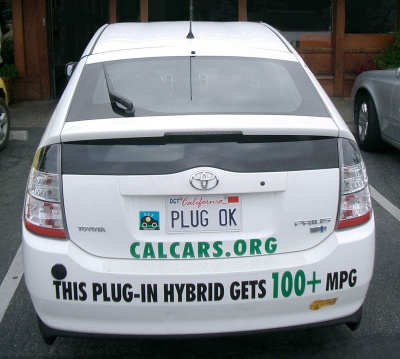 From the Editors of E/The Environmental Magazine
From the Editors of E/The Environmental Magazine
Dear EarthTalk: Should we expect to see "plug-in" hybrid cars anytime soon? I've been hearing they are on the horizon but I wonder if that means in one year or 10. -- Bill A., Stratford, CT

The electricity cost for powering a plug-in hybrid is only about one-quarter of the cost of powering a like-sized gasoline vehicle. Pictured here: a regular Toyota hybrid Prius converted to a 100 miles-per-gallon (avg.) plug-in by the California Cars Initiative, a nonprofit group dedicated to accelerating the availability of the technology. (Photo: jurvetson, courtesy Flickr)
Gasoline-electric hybrids now, like Toyota's popular Prius, don't need to plug in-you just fill their tanks with gasoline and the battery keeps charged by the internal combustion engine and by energy generated from the wheels when braking (a feature known as "regenerative braking"). The battery then powers the electric motor when it is called into service during idling, backing-up, crawling in gridlock, maintaining speed while cruising, and for extra uphill power when needed. As such, the electric motor is essentially a back-up engine while the hybrid relies mainly on the gasoline engine.
Plug-in hybrids take the concept further by plugging into a regular electric outlet to enable the vehicle to operate solely on its electric motor for ranges of 40-50 miles or more on a single charge. This has profound implications for commuters who need only drive short distances to and from work every day and who may be able to do so solely on electric power. The gasoline engine then becomes the supplemental one for when the car needs to travel farther than the electric engine can take it.
According to researchers at the University of California Davis, the electricity cost for powering a plug-in hybrid is only about one-quarter of the cost of powering a like-sized gasoline vehicle. Other benefits include far fewer fill-ups at gas stations and the convenience of recharging at home.
Toyota, currently the world's largest producer of hybrid vehicles by far thanks to the success of its Prius, announced that it expects to have a commercially viable plug-in hybrid available to consumers as early as 2010 and is now testing prototype versions of plug-in hybrids at two California universities.
Felix Kramer of the California Cars Initiative (CCI), a non-profit dedicated to promoting plug-ins, called Toyota's announcement "stunning and very welcome," and says that these vehicles will be the cleanest practical cars on the road in a world where gas stations dot just about every intersection. The promise of such cars, says CCI on its website, is that drivers will have a "cleaner, cheaper, quieter car for local travel, and the gas tank is always there should you need to drive longer distances."
U.S. automakers are also jumping onto the plug-in bandwagon. General Motors says that it will have mass-market plug-in hybrids-modifications of its Saturn Vue and Chevrolet Volt-on the road by 2010. Ford has also developed a small fleet of plug-ins, but is not yet ready to offer them to the public. Fisker, a U.S. start-up focusing on the creation of high performance, energy efficient vehicles, plans to sell an $80,000 plug-in hybrid sports car by late 2009. Chrysler's Sprinter van was the first plug-in from a major U.S. manufacturer, but it is only presently available to a limited number of institutions as a fleet vehicle.
Plug-ins have also caught on elsewhere. Chinese carmaker BYD plans to sell a plug-in hybrid sedan in the U.S. within five years. And Volkswagen hopes to have a plug-in hybrid Golf ready to roll by 2010.
CONTACTS: California Cars Initiative, www.calcars.org; BYD, www.byd.com; General Motors, http://www.gm.com/...; Fisker, http://jalopnik.com/....
Dear EarthTalk: I was intrigued to hear that there were a number of ways one could modify or construct a roof on a house or office facility that would provide great environmental benefit. Can you enlighten? -- Bill Teague, Menlo Park, CA

Green roofs utilize living plant matter and soil on top of a building in order to absorb, collect and reuse rainwater while preventing run-off. Pictured: A green roof demonstration project at the Chicago Center for Green Technology. (Photo: Andrew Ciscel, courtesy Flickr)
Minimizing this run-off means that more impurities will remain in local soils where they can be broken down more easily into their constituent elements than if they are concentrated downstream. In order to achieve this goal, landscape architects have developed so-called "green roofs," which utilize living plant matter and soil on top of a building in order to absorb, collect and reuse rainwater while preventing run-off. Many buildings employing green roofs are able to find abundant uses for the water they collect, from watering exterior plantings at ground level to flushing toilets inside.
According to Steven Peck of the Toronto-based non-profit Green Roofs for Healthy Cities, green roofs can play an important role in maintaining ecological integrity within otherwise paved over areas. "The roofscapes of our cities are the last urban frontier-from 15 percent to 35 percent of the total land area-and the green roof industry can turn these wasted spaces into a force for cleaner air, cleaner water, energy savings, cooling, beauty and recreation," he says.
The U.S. Environmental Protection Agency (EPA) encourages the creation of green roofs for mitigating the urban "heat island effect," whereby temperatures in crowded cities can soar some 10 degrees Fahrenheit higher than in less developed areas nearby. Other benefits, says the EPA, include: providing amenity space for tenants (in effect replacing a yard or patio); reducing building heating and cooling costs due to the buffering effect of the plant matter and soil; filtering pollutants like carbon dioxide out of the air and heavy metals out of rainwater; and increasing bird habitat in otherwise built-up areas.
Beyond going all out to build a "living" green roof, certain inorganic materials can also make an existing roof greener. The non-profit Cool Roof Rating Council (CRRC), for instance, suggests roofing surfaces that reflect the sun's heat so as to reduce the urban heat island effect while improving residential energy efficiency. According to the group, "a cool roof reflects and emits the sun's heat back to the sky." Builders can check out CRRC's website for a database of information on the radiative properties of various roofing surfaces so as to make the smartest choice for clients and the environment.
Another quality that makes certain roofs greener than others is how long they last. Metal roofs are known to be relatively maintenance free and last longer than shingles in most situations. Slate roofs also have an excellent reputation for lasting long, although getting work done on them can be expensive when they do need repairs. The Slate Roofing Contractors Association reports that sea green slates can last anywhere from one to two centuries, depending on where the slate is quarried and how well it's eventually installed.
CONTACTS: Green Roofs for Healthy Cities, www.greenroofs.org; CRRC, www.coolroofs.org.
Dear EarthTalk: What are the major environmental issues that our next president, be it Obama or McCain, will have to confront? -- Melinda Barnes, via e-mail

Global warming is the biggest issue facing our next president. Both Barack Obama and John McCain are committed to tackling climate change, although their proposed approaches differ in significant ways. (Photo: Getty Images)
Global warming is unquestionably the most pressing environmental issue facing whoever ends up in the White House in January 2009. Not only does climate change impact-and in most cases exacerbate-other environmental problems, it has even wider implications for the economy and society at large. Luckily for all of us, both Barack Obama and John McCain are committed to tackling climate change, although their proposed approaches differ in significant ways.
The non-profit League of Conservation Voters (LCV), America's leading voice for environmental advocacy within electoral politics, would prefer to see Obama elected president given his environmental track record and plans for the future. While both candidates favor instituting a mandatory "cap-and-trade" program (whereby the federal government allows polluters to trade for the right to emit a reduced overall amount of greenhouse gases), Obama is for more strident cuts. He would like to see the U.S. reduce its greenhouse gas emissions by some 80 percent by 2050, while McCain supports only cutting back by 65 percent. Both candidates have authored legislation in the Senate designed to reduce greenhouse gas emissions, although no such bills have come close to passing.
Even though McCain is by far the most forward-thinking of the original Republican presidential contenders on global warming and the need to take action, LCV still gives him poor marks, only a 24 rating (out of 100) lifetime and zero for 2007. LCV says that McCain missed all 15 critical environmental votes last year and that he "repeatedly clings to outdated policies and flip-flops on core environmental issues." By comparison, Obama earned a score of 67 in 2007, because he missed four votes due to campaigning (his 2006 score was 100), and has a lifetime LCV rating of 86.
One area where environmentalists take issue with McCain is his support for expanding the role of nuclear power in cutting fossil fuel use. Obama would rather bolster alternative energy sources like wind and solar power that do not have the nasty side effect of radioactive waste in need of storage and disposal. (McCain also supports the development of new renewables, but not to the extent that Obama is willing to commit).
Some of the other hot button environmental issues sure to occupy the next president's time include: how to best protect the nation's water resources and wetlands; whether to allow more drilling for oil and natural gas both offshore and within Alaska's Arctic National Wildlife Refuge; whether to reinstate the Roadless Area Conservation Rule, a Clinton-era law (subsequently overturned by the Bush administration) calling for protection of some 58 million acres of public land from logging; how to meet U.S. commitments on existing environmental laws in international trade agreements; and whether to bring back the so-called "polluter pays" part of the government's "Superfund" toxic waste clean-up program.
While Obama is clearly the greener candidate on most of these issues, the fact that McCain even takes them seriously-and is committed to any greenhouse gas reductions whatsoever-is a plus for environmental advocates exasperated by eight years of green naysaying by the Bush administration.
CONTACTS: Obama '08, www.barackobama.com; McCain for President, www.johnmccain.com; League of Conservation Voters, www.lcv.org.
GOT AN ENVIRONMENTAL QUESTION? Send it to: EarthTalk, c/o E/The Environmental Magazine, P.O. Box 5098, Westport, CT 06881 or submit it via e-mail: earthtalk@emagazine.com.


